Who Controls the User Experience? AMD’s Carrizo Thoroughly Tested
by Ian Cutress on February 4, 2016 8:00 AM ESTBenchmark Results: Professional and OpenCL
Here are our results from our Professional and OpenCL tests. A reminder of our systems, including their graphics:
| System Overview | ||||
| µArch | APU + GPU | Memory | Channel | |
| HP Elitebook 745 G2 | Kaveri | A10 PRO-7350B (19W) R6, 384 SPs, 533 MHz |
8 GB | Dual |
| HP Elitebook 745 G3 | Carrizo | PRO A12-8800B (15W) R7, 512 SPs, 800 MHz |
4 GB | Single |
| Toshiba Satellite E45DW-C4210 |
Carrizo | FX-8800P (15W) R7, 512 SPs, 800 MHz |
8 GB | Single |
| HP Pavilion 17z-g100 |
Carrizo | A10-8700P (15W) R6, 384 SPs, 800 MHz |
8 GB | Single |
| Lenovo Y700 | Carrizo | FX-8800P (15W) R7, 512 SPs, 800 MHz R9 385MX, 512 SPs, 900-100 MHz |
16 GB | Single |
PCMark 08
PCMark08, developed by Futuremark, is a simple press play and run benchmarking tool designed to probe how well systems cope with a variety of standard tasks that a professional user might encounter. This includes video conferencing with multiple streams, image/file manipulation, video processing, 3D modelling and other tools. In this case we take the three main benchmark sets, Creative, Home and Work, and run them in OpenCL mode which aims to take advantage of OpenCL accelerated hardware. For fun we also put in the PCMark08 Storage workset.
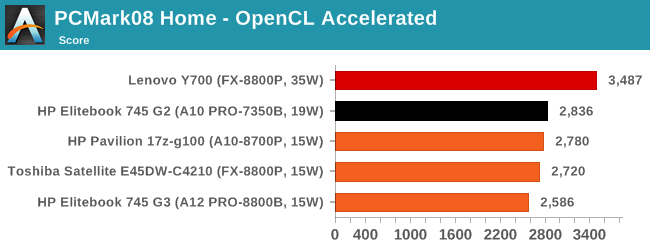
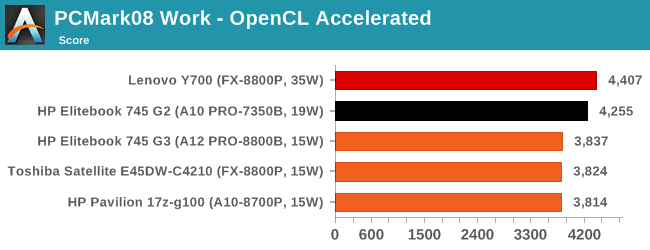
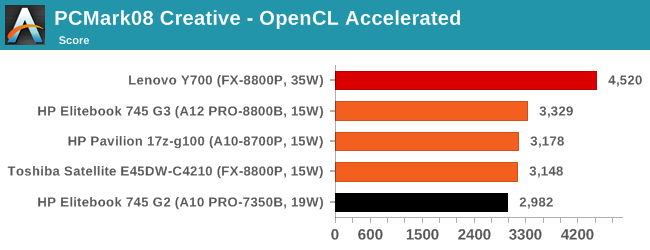
Both of the Home and Work tests show something starteling in the Kaveri system beating all the 15W Carrizo parts. This comes back to what we saw on WebXPRT on the last page – these workloads are very bursty in nature, requiring the system to wake up, run a small amount of work, and go back to sleep. It would seem that this requires a lot more effort from the Carrizo platforms than the Kaveri ones (perhaps by nature of the lower idle power draw starting point on Carrizo) which impacts time critical performance metrics.
If we take the CPU frequencies of the two Elitebook systems, starting with the 745 G2 (Kaveri)
Here the standard frequency tends to be in the 3300 MHz region, moving down to lower frequencies when more threads are needed. But for the 745 G3 (Carrizo):
Here the CPU frequency is obviously mostly at the 2500 MHz mark, sometimes bursting up to 3400 MHz (It’s actually more of a 2:1 split in favor of 2500 MHz).
You might argue that the temperature of the design might be to blame. Both Elitebooks are in the same chassis, so let us see:
(take note of the scales)
Here it shows the G2 wanting to stay below 60C, whereas the G3 is happy to go almost to 80C, albeit with an average temperature which is nearer 50C. This means that the G2 can arguably keep the higher frequencies for longer.
Just to weigh in on the other 15W Carrizo designs in the Toshiba Satellite and HP Pavilion:
In both cases, similar to the G3, the main frequency for the test is actually the lower 2500/2300 frequency, with the system moving up to the higher frequency state around a third of the time, rather than staying at the higher state and moving back down. This is what is causing the Kaveri system to win out in these sorts of workloads (though likely at a power penalty).
On the storage front, having a mechanical drive is a killer here.

Agisoft Photoscan
Photoscan is professional software that takes a series of 2D images (as little as 50, usually 250+) and 'performs calculations' to determine where the pictures were taken and if it can create a 3D model and textures of what the images are of. This model can then be exported to other software for touch-ups or implementation in physics engines/games or, as the reader that directed me to it, national archiving. The tool has four phases, one of which can be OpenCL accelerated, while the other three are a mix of single thread and variable thread workloads. We ran the tool in CPU only and OpenCL modes.
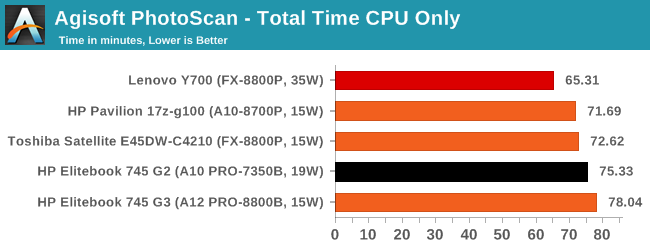
When pure CPU performance matters, having the higher thermal headroom matters most. But moving it to the OpenCL mode shows that those extra TDP points can matter a lot on load balancing:
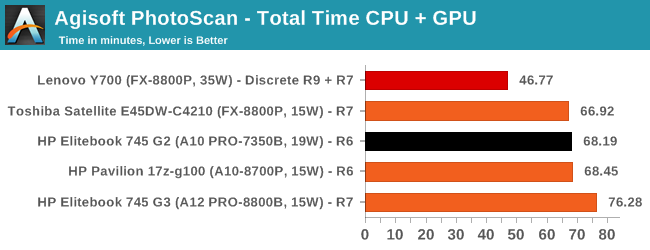
There are two things to note here. One, something seems to have gone very wrong with the G3, and I’m sure those numbers are erroneous and need to be re-run or the 4GB of memory is actually a hindrance here. The second is that the combination R7/R9 graphics in the Lenovo, despite not being in Crossfire, can both be used in OpenCL mode. This pushes a speed up of almost 30%.
Linux Bench
Linux Bench is a collection of Linux based benchmarks compiled together by ServeTheHome. The idea for this is to have some non-windows based tools that are easy enough to run with a USB key, an internet connection and three lines of code in a terminal. The tests in Linux Bench include standard synthetic compute, compression, matrix manipulation, database tools and key-value storage.
Unfortunately Linux Bench refused to run on any of the HP systems for relatively unknown reasons – the fact that it was all the HP models perhaps means that there is something firmware related which is causing the LiveCD to not boot properly. Nonetheless, the results are here for completeness.
| Linux Bench | ||
| Toshiba Satellite E45DW-C4210 (15W) |
Lenovo Y700 (35W) |
|
| C-Ray Hard Test / seconds | 365 | 267 |
| 7-Zip Compression MIPS | 5718 | 6110 |
| 7-Zip Decompression MIPS | 7320 | 9733 |
| NAMD (steps per time) | 1.72 | 2.46 |
| NPB MOPS (per sec per thread) | 365 | 321 |
| OpenSSL Sign | 220 | 296 |
| OpenSSL Verify | 13518 | 19465 |
| Redis 1 | 13210 | 12034 |
| Redis 10 | 41494 | 38760 |
| Redis 100 | 33445 | 31949 |






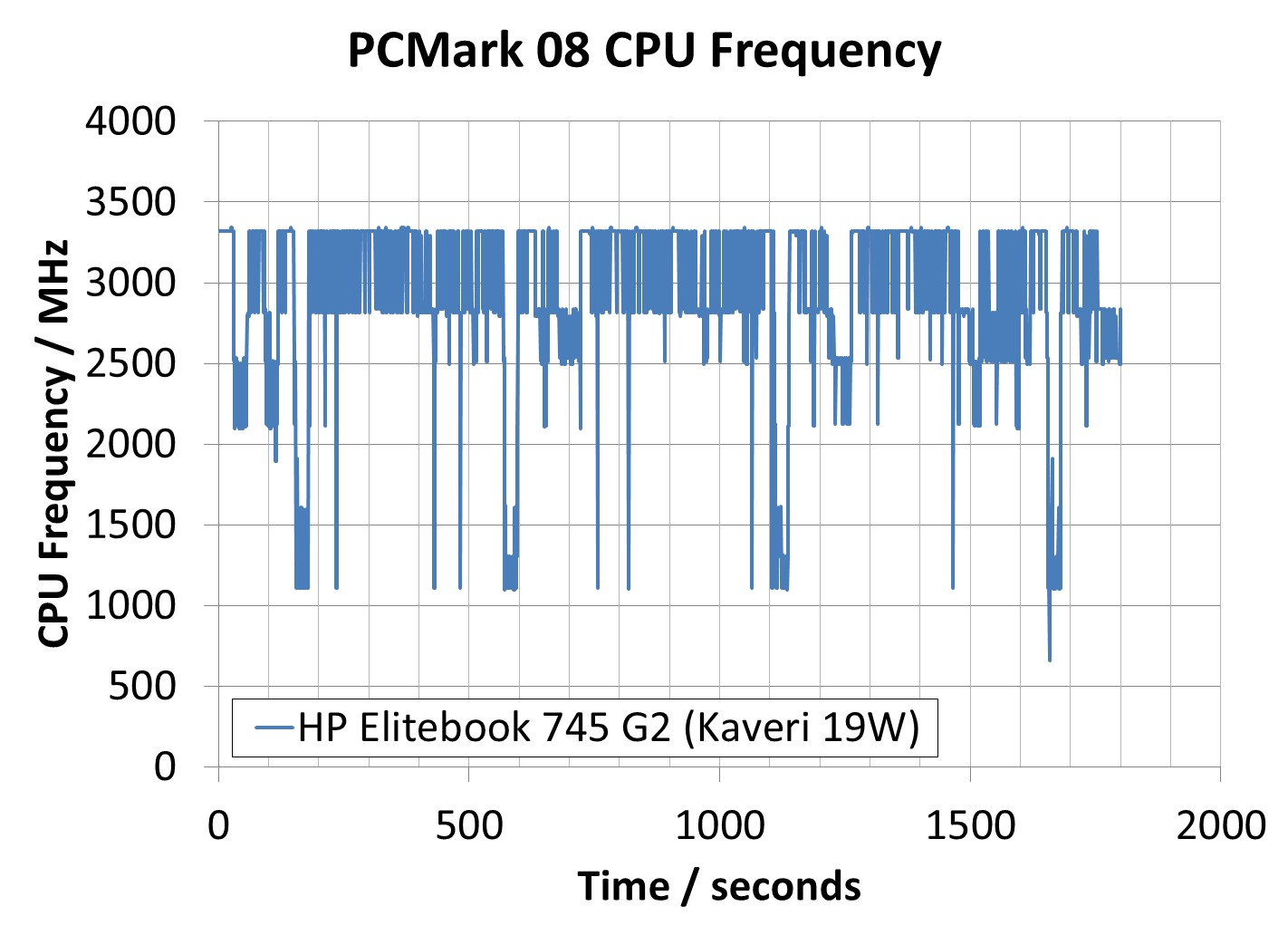

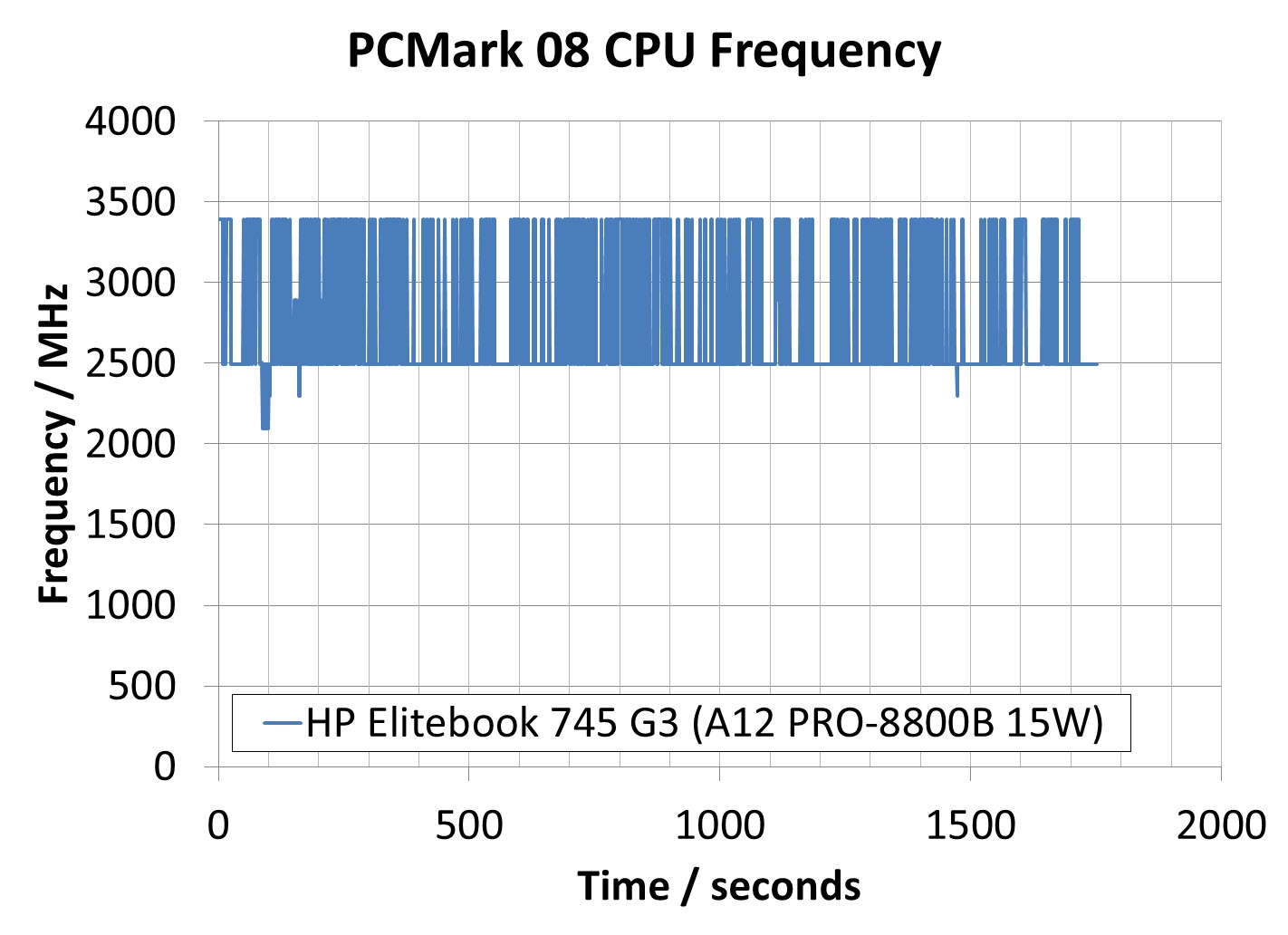
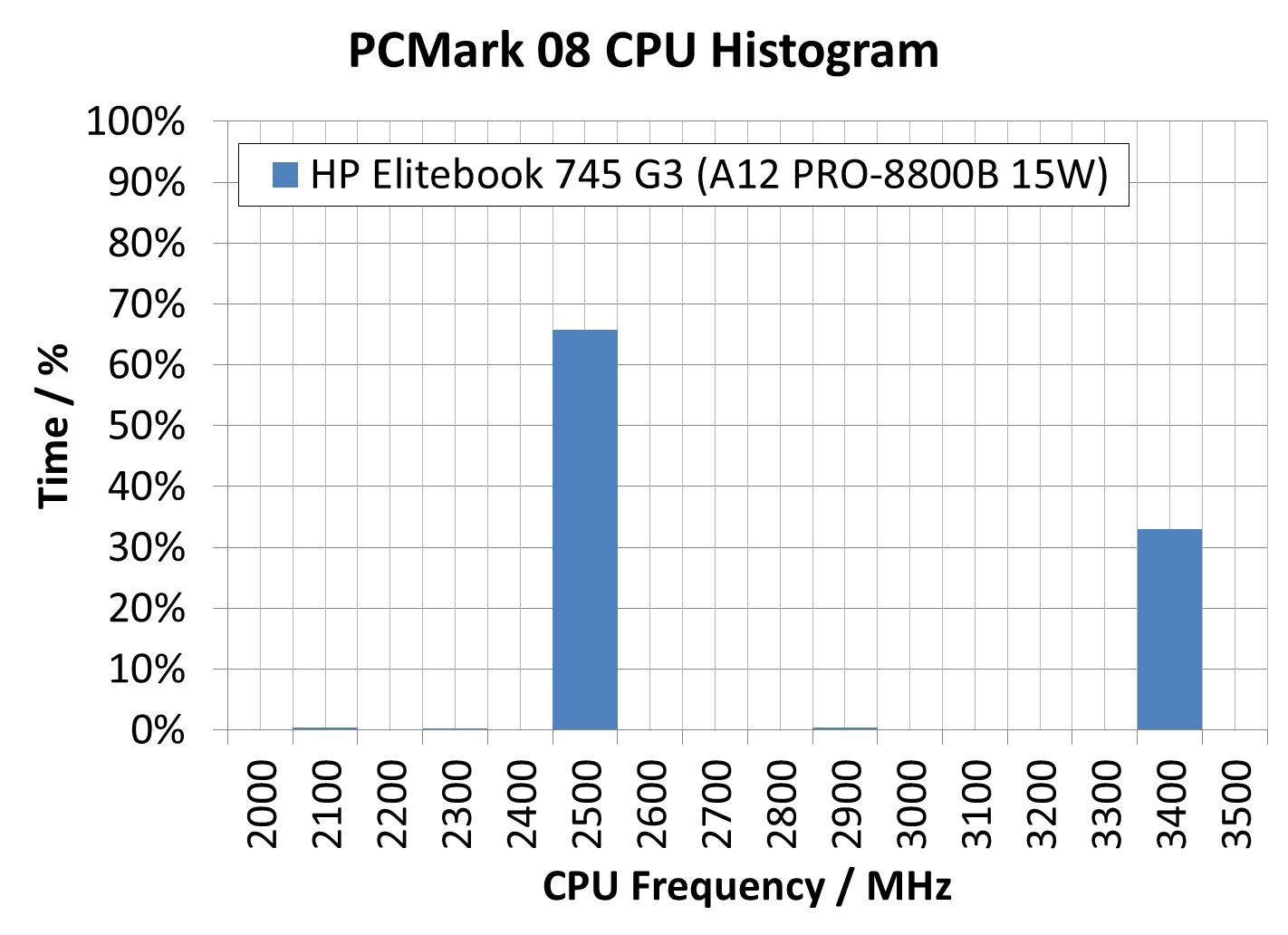

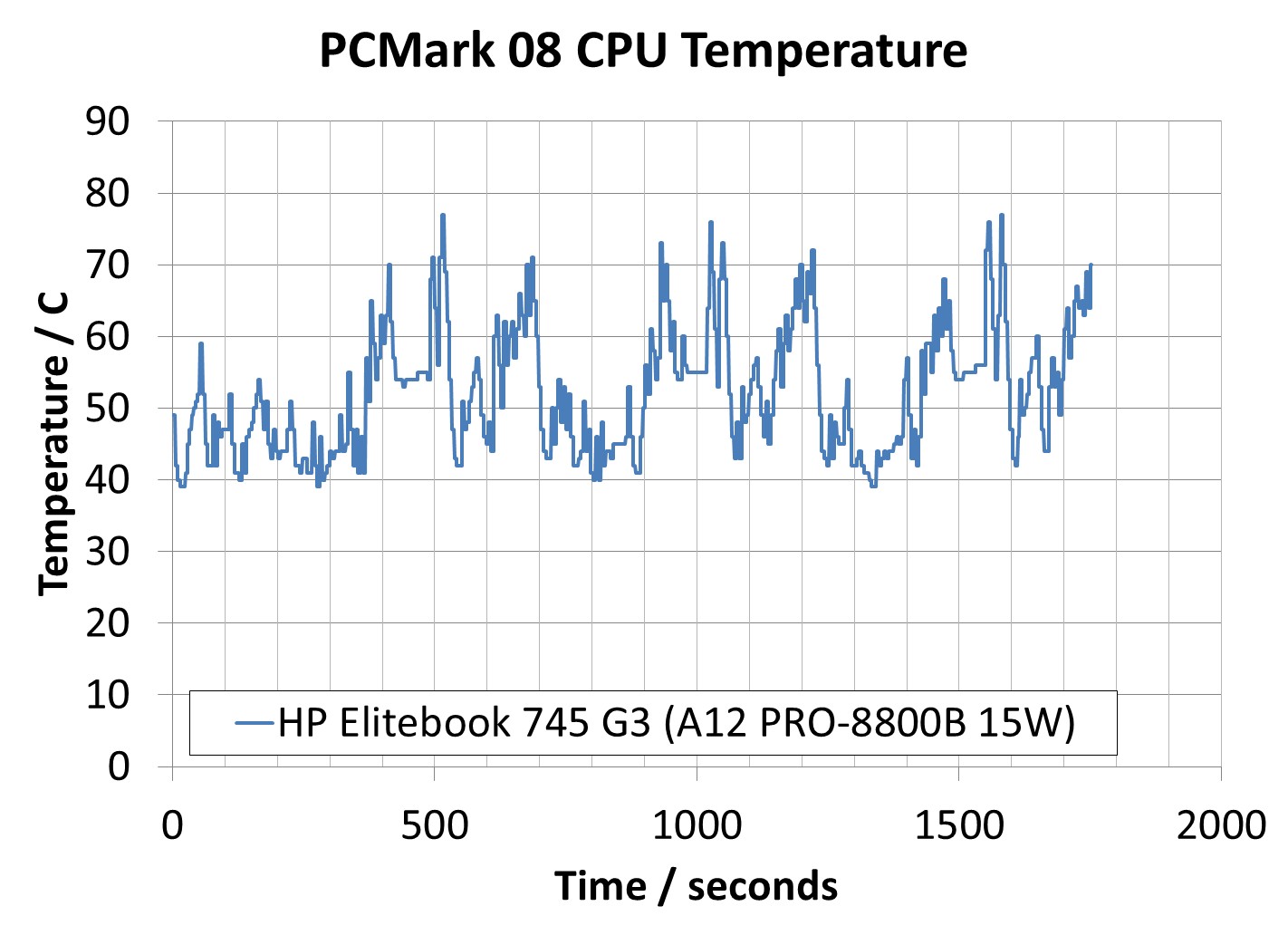










175 Comments
View All Comments
MonkeyPaw - Friday, February 5, 2016 - link
The cat cores exist to compete with Atom-level SOCs. Intel takes the Atom design from phones and tablets all the way up to Celeron and Pentium laptops. It makes some business sense due to low cost chips, but if the OEM puts them in a design and asks too much of the SOC, then there you have a bad experience. Such SOCs should not be found in anything bigger than a $300 11" notebook. For 13" and up, the bigger cores should be employed.michael2k - Friday, February 5, 2016 - link
The cat cores can't compete with Atom level SoC because they don't operate at low enough power levels (ie, 2W to 6W). The cat cores may have been designed to compete with Atom performance and Atom priced parts, but they were poorly suited for mobile designs at launch.Intel999 - Sunday, February 7, 2016 - link
AMD hasn't updated the cat cores in over three years! It is a dead channel to them. They had a bit of a problem competing in the tablet market against a competitor that was willing to dump over $4 billion pushing inferior bay trail chips. Take a plane to China and you can still find a lot of those Bay Trail chips sitting in warehouses as once users had the misfortune of using tablets being run by them the reviews destroyed any chance that those tablets ever had at being sales successes.AMD was forced to stop funding R&D on cat cores as they were in no position to be selling them at negative $5.
In the time that AMD has stopped development on the cat cores Intel has improved their low end offerings, but still not enough to compete with ARM offerings that have improved as well. And now tablets are dropping at similar rates to laptops so it is actually a good thing for AMD that they suspended research on the cat cores. Sorta dodged a bullet.
At least they still get decent volume out of them through Sony and Microsoft gaming platforms.
testbug00 - Friday, February 5, 2016 - link
If the cat cores didn't exist AMD likely would have died as we know it a few years ago.
BillyONeal - Friday, February 5, 2016 - link
The "cat cores" are why AMD is not yet bankrupt; it let them get design wins in the PS4 and XBox One which kept the company afloat.mrdude - Friday, February 5, 2016 - link
YoY Q4 earnings showed a 42% decline in revenue for computing and graphics with less than 2bn in revenue for full-year 2015 and $502m operating loss. You couldn't be more correct. The console wins aren't just keeping the company afloat, they practically define it entirely.Lolimaster - Friday, February 5, 2016 - link
In that case simply remove the OEM's altogether and sell it at AMD's store or selected physical/online stores.TheinsanegamerN - Thursday, February 11, 2016 - link
10/10 would pay for an "AMD" branded laptop that does APUs correctly.Hrobertgar - Friday, February 5, 2016 - link
Since you are talking about use experience, AMD is not the only company with a bad user experience. I purchased an Alienware 15" R2 laptop on cyber Monday and it is horrible, and support is horrible. I compare my user experience to a Commodore 64 using a Cassette drive - its that bad (I suspect you are old enough to appreciate cassette drives). It arrived in a non-bootable configuration. It cannot stream Netflix to my 2005 Sony over an HDMI cable unless I use Chrome - took Netflix help to solve that (I took a cell-phone pic of a single Edge browser straddling the two monitors - the native monitor half streaming video and the Sony half dark after passing over the hdmi cable. It only occurs with Netflix). On 50% of bootups it gives me a memory change error despite even the battery being screwed in. On 10% of bootups it fails to recognize the HDD. Once it refused to shutdown and required holding the power button for 10 secs. Lately it claims the power brick is incompatible on about 10% of bootups. Yes, I downloaded all latest drives, bios, chipset, etc. Customer Service has hanged up on me once, deleted my review once, and repeatedly asked for my service tag after I already gave it to them. Some of the Netflix issue is probably Micorsoft's issue - certainly MS App was an epic fail, but much of even that must be Dell's issue. I realize it is probably difficult to spot many of these things given the timeframe of the testing you do, and the Netflix issue in particular is bizarre. I am starting to think a Lenovo might not be so bad.tynopik - Friday, February 5, 2016 - link
"put of their hands"